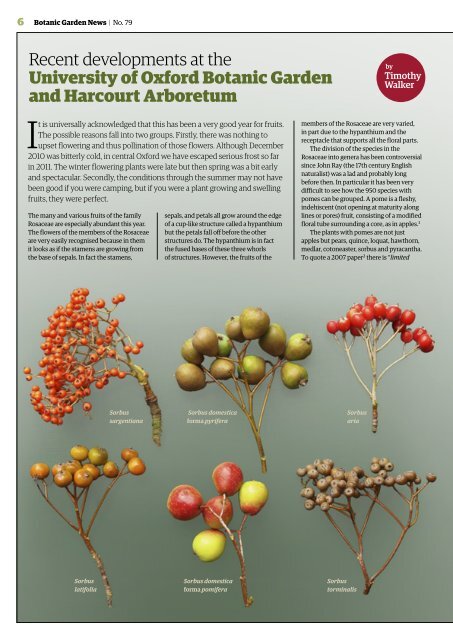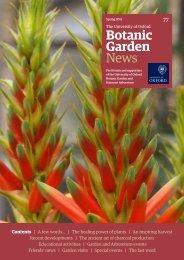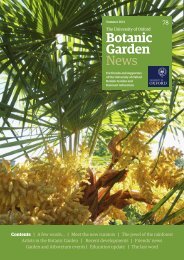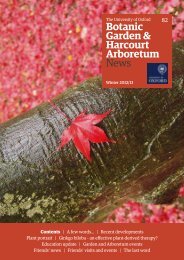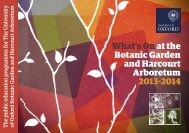Autumn/Winter 2011/12 - Harcourt Arboretum - University of Oxford
Autumn/Winter 2011/12 - Harcourt Arboretum - University of Oxford
Autumn/Winter 2011/12 - Harcourt Arboretum - University of Oxford
Create successful ePaper yourself
Turn your PDF publications into a flip-book with our unique Google optimized e-Paper software.
6<br />
Botanic Garden News | No. 79<br />
Recent developments at the<br />
<strong>University</strong> <strong>of</strong> <strong>Oxford</strong> Botanic Garden<br />
and <strong>Harcourt</strong> <strong>Arboretum</strong><br />
by<br />
Timothy<br />
Walker<br />
It is universally acknowledged that this has been a very good year for fruits.<br />
The possible reasons fall into two groups. Firstly, there was nothing to<br />
upset flowering and thus pollination <strong>of</strong> those flowers. Although December<br />
2010 was bitterly cold, in central <strong>Oxford</strong> we have escaped serious frost so far<br />
in <strong>2011</strong>. The winter flowering plants were late but then spring was a bit early<br />
and spectacular. Secondly, the conditions through the summer may not have<br />
been good if you were camping, but if you were a plant growing and swelling<br />
fruits, they were perfect.<br />
The many and various fruits <strong>of</strong> the family<br />
Rosaceae are especially abundant this year.<br />
The flowers <strong>of</strong> the members <strong>of</strong> the Rosaceae<br />
are very easily recognised because in them<br />
it looks as if the stamens are growing from<br />
the base <strong>of</strong> sepals. In fact the stamens,<br />
sepals, and petals all grow around the edge<br />
<strong>of</strong> a cup-like structure called a hypanthium<br />
but the petals fall <strong>of</strong>f before the other<br />
structures do. The hypanthium is in fact<br />
the fused bases <strong>of</strong> these three whorls<br />
<strong>of</strong> structures. However, the fruits <strong>of</strong> the<br />
members <strong>of</strong> the Rosaceae are very varied,<br />
in part due to the hypanthium and the<br />
receptacle that supports all the floral parts.<br />
The division <strong>of</strong> the species in the<br />
Rosaceae into genera has been controversial<br />
since John Ray (the 17th century English<br />
naturalist) was a lad and probably long<br />
before then. In particular it has been very<br />
difficult to see how the 950 species with<br />
pomes can be grouped. A pome is a fleshy,<br />
indehiscent (not opening at maturity along<br />
lines or pores) fruit, consisting <strong>of</strong> a modified<br />
floral tube surrounding a core, as in apples. 1<br />
The plants with pomes are not just<br />
apples but pears, quince, loquat, hawthorn,<br />
medlar, cotoneaster, sorbus and pyracantha.<br />
To quote a 2007 paper 2 there is “limited<br />
Sorbus<br />
sargentiana<br />
Sorbus domestica<br />
forma pyrifera<br />
Sorbus<br />
aria<br />
Sorbus<br />
latifolia<br />
Sorbus domestica<br />
forma pomifera<br />
Sorbus<br />
torminalis


